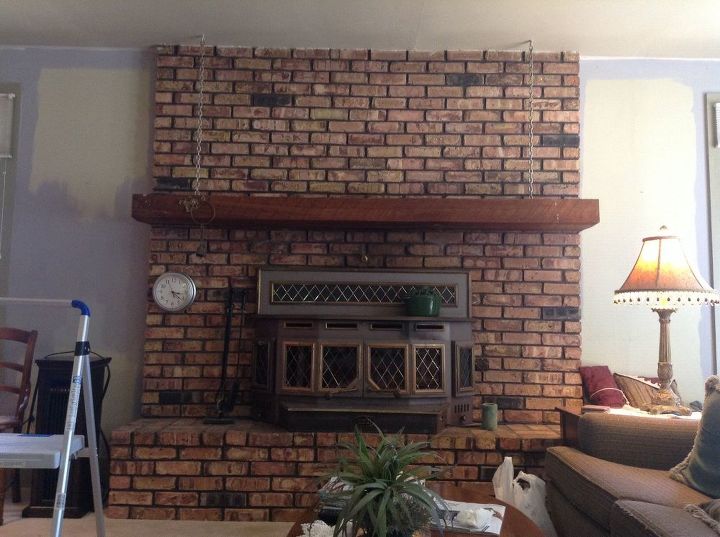Can I paint over wallpaper in a bathroom?
Related Discussions
Should I paint or stain my oak kitchen cabinets?
I was wondering if you could help me with something -- I have an entirely oak kitchen. I know it's the rage now to paint or gel stain cabinets. I've been considering ... See more
How to paint a metal front door?
How do I paint my front door? It's metal.
How to paint grout?
How do I paint grout to change the color? The grout is in great shape, but the color - meh.
How to whitewash a brick fireplace?
What is the best method to whitewash bricks surrounding a fireplace?
Can melamine paneling be painted it’s in the bathroom??
How can I paint one open wall that connects 2 rooms?
I have one wall that runs from my living room (front of the house) through my kitchen ( back of the house). I would like to start with a darker color and fade to a li... See more




you should not.....doen the road the wall paper will bubble and peal
I wouldn't. The moisture in bathrooms will eventually peel the paper away. Adding paint on top will compromise the seal even more. Better to remove it.
Yes, you can although the seams may shore more than you like. Think of the longterm.......once you paint over it, it will be nearly impossible to remove the wallpaper in later years, if you want too. Maybe best to remove it now, then paint.
No. Removed the wallpaper, but be VERY careful so you don't damage the drywall, or you will have to re-drywall. Been there, done that, just so you know. An experienced paper hanger told me the best way to remove wallpaper is to mist the paper with very hot water in small sections and carefully scrape away the old paper. Or use a wallpaper steamer.
I wish - mine is terribly ugly so I will be tackling this soon. No one has given me a very enthusiastic yes to painting over it. If you are going to attempt it, here are some instructions:
Step 1 - Prep the Wall
Start by checking how well the wallpaper is affixed to the walls. If there are loose areas, remove them using a utility knife. Remove all nails and any switch plates from the wall, and use masking tape to protect the baseboard. Put a drop cloth at the bottom of the wall to catch paint.
Finally, make sure that the room is well ventilated for what’s to come, and put on any and all protective clothing, masks, and safety glasses to protect your eyes. Fumes from the primers and paints can be harmful if inhaled or over long periods of exposure.
Step 2 - Apply Primer
Paint the wall with primer. Be sure to use a primer that is either shellac or oil-based. If you use a water-based primer, it can lift off the wallpaper or cause it to bubble. The shellac and oil-based primers bond hard and dry quickly. They also tend to be more opaque to cover stains and old patterns more effectively.
Step 3 - Repair Wall
Once dry, the layer of primer will still show all the deficiencies in the wall. Fix these with drywall compound, which will also cover the seams between wallpaper.
Put a thin coat over the seams and any holes or defects on the wall. Let it dry, then sand it down. To achieve proper coverage, you might need two coats of drywall compound. Once you’re satisfied with the way it looks, apply primer over the areas of drywall compound, then caulk around the trim and the ceiling line.
Once this latest application of primer and caulk has dried, apply masking tape at the ceiling line. To get rid of all the dust from the drywall, you can use a shop vac with the crevice tool attached.
Step 4 - Apply Texture (Optional)
If you want to use texture on the wall when you paint, apply it once the primer is on the wall. Once you’re happy with it, allow it to dry, and then paint over the top of it. You’ll need more paint to properly cover a textured wall. You can also add another coat that contrasts or complements the paint.
Step 5 - Paint
Use an eggshell paint or a washable flat paint when painting over wallpaper. These varieties give a much lower sheen than other types of paint and can help hide any remaining irregularities in your wall. Start by using your brush around the edges and the trim on the walls, painting in long vertical strokes, moving in horizontal patterns only where necessary. You need to cut-in by a distance of at least 6 inches from the edges.
For the rest of the wall, you can use a brush with long, even strokes or a roller. Apply a single coat then allow it to dry. For better coverage, apply a second coat edge first, then cover the entire wall.
Good luck and let us know how it goes!!